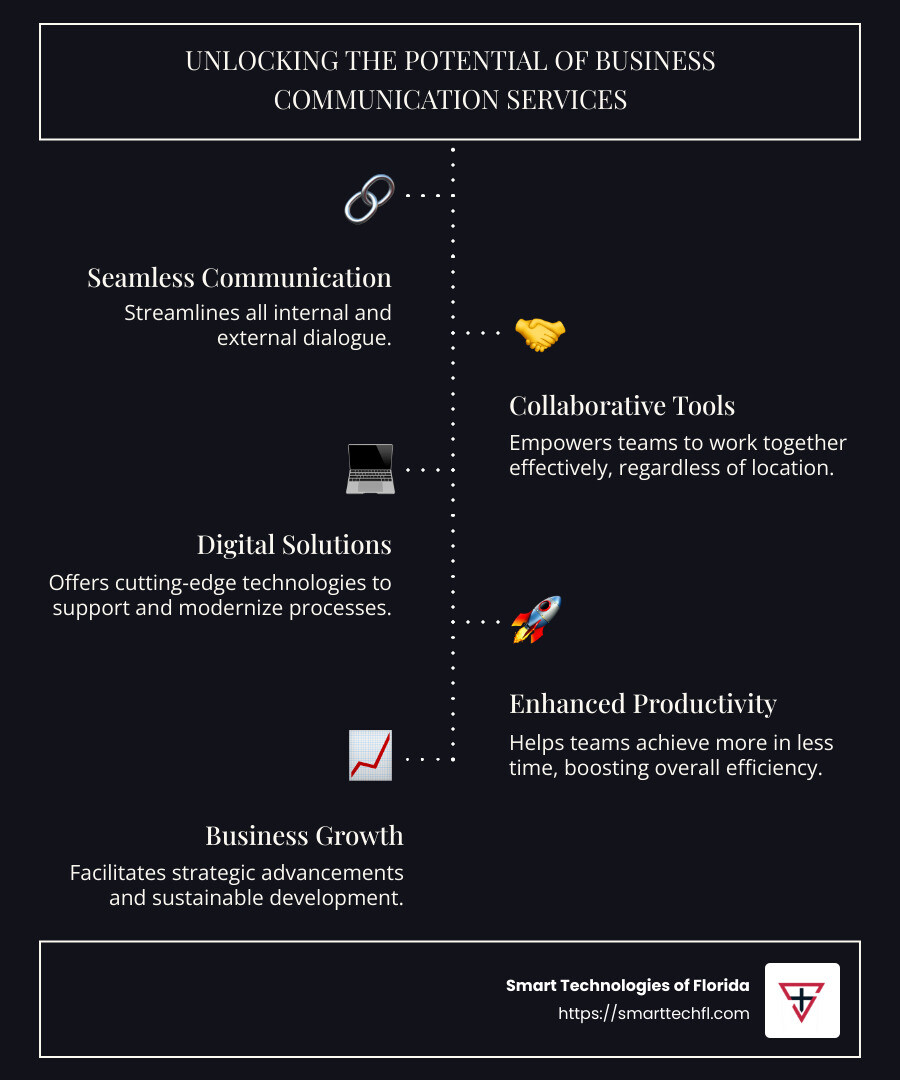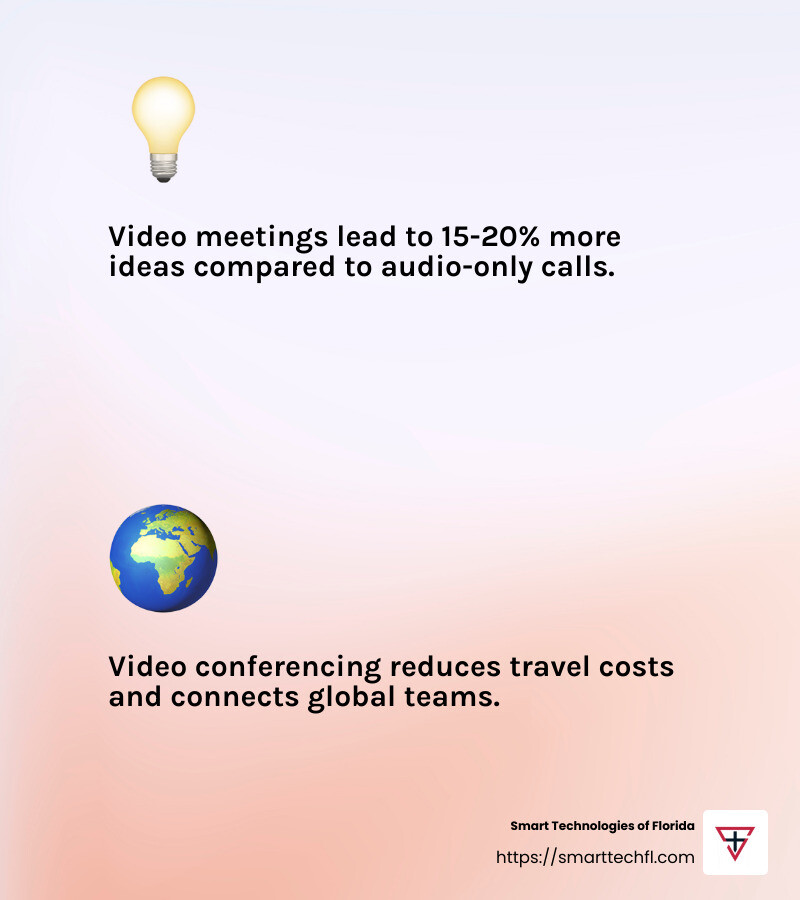Business Communication Services: Bridging the Gap
The Power of Business Communication Services
Business communication services are the backbone of any organization aiming to excel in today’s , digital world. Whether you’re striving to boost efficiency, improve collaboration, or leverage digital solutions, optimizing your communication methods is crucial.
At a glance, here’s what business communication services can cover:
- Seamless Communication: Streamlines all internal and external dialogue.
- Collaborative Tools: Empowers teams to work together effectively, regardless of location.
- Digital Solutions: Offers cutting-edge technologies to support and modernize processes.
When remote work and digital operations are becoming the norm, businesses across all sectors are seeking ways to stay connected and drive growth. As organizations evolve, the need for robust, efficient communication infrastructure only becomes more vital.
Incorporating advanced communication services is a strategic move that open ups potential across teams, improves productivity, and ultimately, helps companies thrive.

Understanding Business Communication Services
Business communication services are more than just tools—they’re essential for connecting teams and improving productivity. Let’s break down the key elements that make these services indispensable:
Voice Solutions
Voice technology remains at the core of effective business communication. While emails and texts are great for routine exchanges, voice solutions like VoIP systems provide the immediacy and clarity needed for critical conversations. With the workforce becoming more mobile, many companies are turning to cloud-based phone systems. These systems offer flexibility, allowing employees to make and receive calls from anywhere.

Video Meetings
Video conferencing has transformed how businesses meet and collaborate. With tools like Microsoft Teams, video meetings bring people together, whether they’re in the same office or across the globe. This method of communication not only reduces travel costs but also fosters a more personal connection than emails or calls alone. Research shows that face-to-face meetings, even virtual ones, can generate up to 15-20% more ideas compared to purely audio-based meetings. 
Software Solutions
Software solutions are the backbone of modern business communication. Unified communications platforms integrate messaging, video, and voice into one seamless system. This integration simplifies IT management and reduces costs, as businesses no longer need separate systems for each function.
Moreover, cloud-based platforms ensure that all tools are accessible from anywhere, ensuring that employees can collaborate efficiently, regardless of their location. This is particularly important as remote work becomes more prevalent.
By leveraging these communication services, businesses can improve collaboration, streamline operations, and ultimately drive growth. As we dig into the types of business communication, it’s clear that the right tools can bridge gaps and empower teams to succeed.
Types of Business Communication
In any organization, communication flows in various directions, each serving a unique purpose. Understanding these types can help businesses improve efficiency and foster a better workplace environment. Let’s explore the four main types of business communication:
Internal Upward Communication
This type of communication moves from the lower levels of an organization to the upper levels. Think of it as feedback flowing up the chain. It includes performance reports, employee surveys, and suggestions for improvement. When done right, it empowers employees to share their experiences and insights, playing a crucial role in improving job performance. For instance, a study from the research shows that transparent upward communication can lead to higher employee satisfaction and better decision-making by management.
Internal Downward Communication
This is the flow of information from the management to the employees. It includes directives, memos, and policy announcements. Clear and effective downward communication ensures that everyone in the organization understands their tasks and responsibilities. It helps prevent misunderstandings and operational errors. Imagine receiving a memo about a new company policy—this is a classic example of downward communication in action.
Internal Lateral Communication
Lateral communication happens between colleagues at the same organizational level. It facilitates coordination and collaboration among team members. This includes meetings, emails, and team briefings. Effective lateral communication ensures that tasks are understood and executed correctly. For example, a quick email exchange between team members to clarify a project detail is a form of lateral communication.
External Communication
This type of communication occurs between the organization and external parties, such as customers, vendors, and the public. It includes marketing materials, press releases, and customer service interactions. External communication is vital for maintaining positive relationships outside the company and impacts brand reputation. A well-crafted press release about a new product launch is an example of effective external communication.
By recognizing and optimizing these types of communication, businesses can improve their operations and foster a more collaborative and efficient work environment. Up next, we’ll dive into the key features of business communication services that make these interactions seamless and effective.
Key Features of Business Communication Services
In today’s world, business communication services are more crucial than ever. They help businesses stay connected, efficient, and competitive. Let’s break down the key features that make these services indispensable:
Unified Communications
Unified communications bring all your communication tools into one platform. This means emails, phone calls, video meetings, and instant messaging are all accessible from a single interface. Companies that adopt unified communications see significant improvements in productivity and collaboration. According to the research, organizations like Goodwill Industries of South Florida cut their phone bills by 43% after switching to a unified system. This shows how integrating communication tools can lead to cost savings and better efficiency.
Centralized Communication
Centralized communication is about funneling all conversations into one place. Imagine having all your emails, chat messages, and social media interactions in a single inbox. This setup makes it easier to track conversations and share information within your team. It reduces the chance of missing important messages and streamlines operations. As noted in the research, centralized platforms like Thryv Command Center help small businesses manage their communications more effectively by integrating calls, emails, and social media chats.
Cloud-Based Platforms
Cloud-based platforms offer flexibility and scalability, making them ideal for businesses of all sizes. With cloud solutions, you can access your communication tools from anywhere, on any device. This is perfect for companies with remote or mobile employees. Cloud platforms also reduce the need for expensive on-site equipment and simplify maintenance. The research highlights how hosted systems, like Cloud PBX, provide budget-friendly options with quick implementation and automatic software updates, ensuring that businesses always have the latest features.
By leveraging these key features, businesses can create a seamless communication experience that supports growth, improves collaboration, and improves overall productivity. Let’s explore the numerous benefits of implementing these business communication services in your organization.
Benefits of Implementing Business Communication Services
Implementing business communication services can transform how your organization operates. Let’s explore the key benefits:
Boosted Productivity
When communication is seamless, productivity soars. Unified communication systems bring everything—emails, calls, video meetings—into one place. This reduces the time spent switching between tools. Employees can focus more on their tasks and less on managing multiple platforms. When Goodwill Industries of South Florida adopted a unified system, they saw significant improvements in efficiency. This is a common result when businesses streamline their communication processes.
Cost-Efficiency
Integrating communication services isn’t just about convenience; it’s also about saving money. With unified systems, companies often see a reduction in costs. For example, Goodwill Industries of South Florida cut their phone bills by 43% after implementation. Cloud-based platforms further improve cost-efficiency by eliminating the need for costly on-site equipment and reducing maintenance expenses. This allows businesses to allocate resources to other critical areas, boosting overall financial health.
Scalability
As your business grows, your communication needs will too. Cloud-based platforms offer the flexibility to scale up or down as needed. Whether you’re adding new team members or expanding services, these platforms can adapt without significant additional costs. This scalability ensures that your communication system grows with your business, supporting your goals and maintaining seamless operations.
By adopting business communication services, your organization can achieve greater productivity, cost-efficiency, and scalability. These benefits not only improve daily operations but also position your business for long-term success. Let’s now move on to some frequently asked questions about these services.
Frequently Asked Questions about Business Communication Services
What are business communication services?
Business communication services are tools and software solutions designed to facilitate seamless interaction within an organization. These services include voice solutions like VoIP, video meetings, email services, and contact center software. They help companies stay connected, manage customer interactions, and support internal collaboration. By integrating these tools, businesses can improve communication efficiency and ensure that everyone is on the same page.
What are the four types of business communication?
Understanding the types of business communication is crucial for any organization:
- Internal Upward Communication: This involves information flowing from lower-level employees to higher management. Examples include feedback, reports, and suggestions for improvement.
- Internal Downward Communication: This is the flow of information from management to employees. It includes directives, memos, and policy announcements.
- Internal Lateral Communication: This type occurs between employees at the same level, promoting collaboration and coordination. Team meetings and emails are common forms.
- External Communication: This involves interactions with outside parties like customers and vendors. It includes marketing materials, press releases, and customer service communications.
Each type plays a vital role in ensuring the smooth operation of a business.
What are the 7 C’s of business communication?
The 7 C’s are key principles that ensure effective communication:
- Clarity: Be clear about your message to avoid confusion.
- Conciseness: Use fewer words to convey your message without sacrificing quality.
- Concreteness: Provide specific and vivid information rather than vague details.
- Correctness: Ensure your message is factually and grammatically accurate.
- Coherence: Maintain logical flow and organization in your communication.
- Courtesy: Show respect and consideration for the recipient.
- Completeness: Include all necessary information so the recipient can make informed decisions.
Adhering to these principles helps organizations achieve effective and efficient communication, both internally and externally.
Conclusion
At Smart Technologies of Florida, we believe that effective communication is the backbone of any successful organization. Our commitment to strategic change and a people-centric approach sets us apart in the field of business communication services. By focusing on the unique needs and goals of each client, we ensure that our solutions are not just technologically advanced but also deeply aligned with human factors.
Our 23 years of experience have taught us that change is not just about adopting new tools—it’s about fostering an environment where communication thrives. This means prioritizing solutions that are scalable and adaptable, ensuring they grow alongside your business. Our services are designed to improve productivity, reduce costs, and provide the flexibility needed in today’s world.
With our strategic guidance, businesses can steer the complexities of digital communication with confidence. Whether you’re looking to streamline internal processes or improve customer interactions, our custom solutions can bridge the gap between where you are and where you want to be.
To learn more about how our business communication services can support your organization’s growth, visit our service page. Let’s transform your communication strategy together, ensuring it’s as dynamic and people-focused as your business.












